UiPath vs IBM RPA (2024): Detailed Comparison of 13 Features
In a survey by Deloitte, 64% of respondents claimed that company-wide adoption of an RPA (robotic process automation) platform is now a strategic choice for operational excellence, scalability, and improvement. If you haven’t adopted RPA to automate your organization’s repetitive tasks and business needs, you should start now.
But which RPA vendor should you select? Based on funding and popularity, UiPath is the biggest vendor in the robotic process automation landscape. We want to investigate if real users agree. So we are starting a new series of articles where we pit UiPath against popular RPA vendors.
We are comparing IBM RPA and UiPath based on 12 categories. To minimize biases and ensure a user-driven benchmarking of the features, each category’s winner will be determined by whichever RPA platform has the higher number of positive user reviews– Vox Populi, Vox Dei.

1. Cost
The RPA tool that you pick should be cost effective. IBM’s platform starter pack costs $840 compared to UiPath’s $420.
So, IBM’s software seems to cost more. But IBM offers more licenses. And users criticize UiPath’s high and flat annual costs (Review 1). Licenses are important because for using each tool to automate a process, you need a valid license, like driving a car. And if you’re in an industry with lots of rule-based, mature, automatable processes, you would need a lot of licenses.
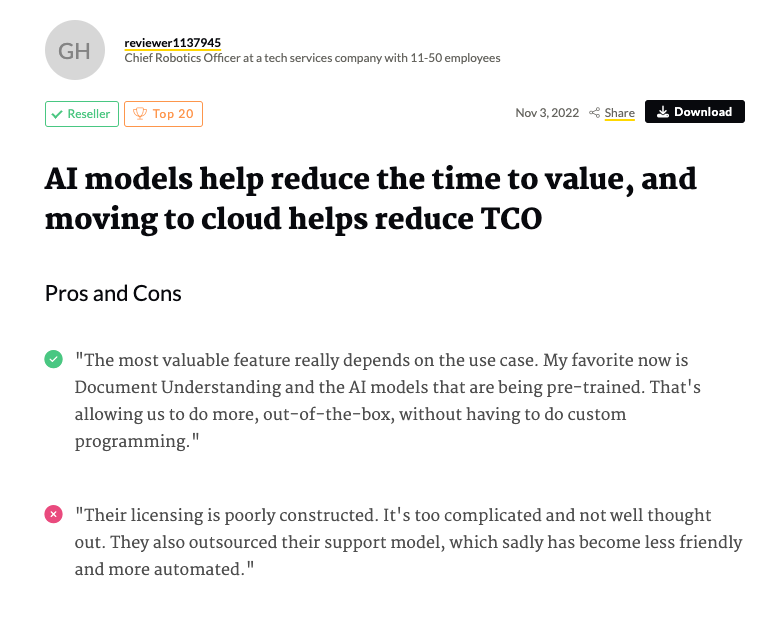
UiPath’s high licensing costs makes their services unattainable for an organization with a limited budget (Review 2).

In comparison, the licensing rate for IBM RPA platform is calculated per usage capacity, making their pricing more flexible and tailored to business needs (Review 3).

So, in the long run, IBM is more cost effective. And IBM offers a better value for the price (Review 4).

2. Cognitive capability
Cognitive capabilities improve the performance of the bots as they repeatedly interact with data.
IBM RPA platform has decent machine learning and artificial intelligence features. These tools power intelligent process automation with limited human intervention (Review 5).
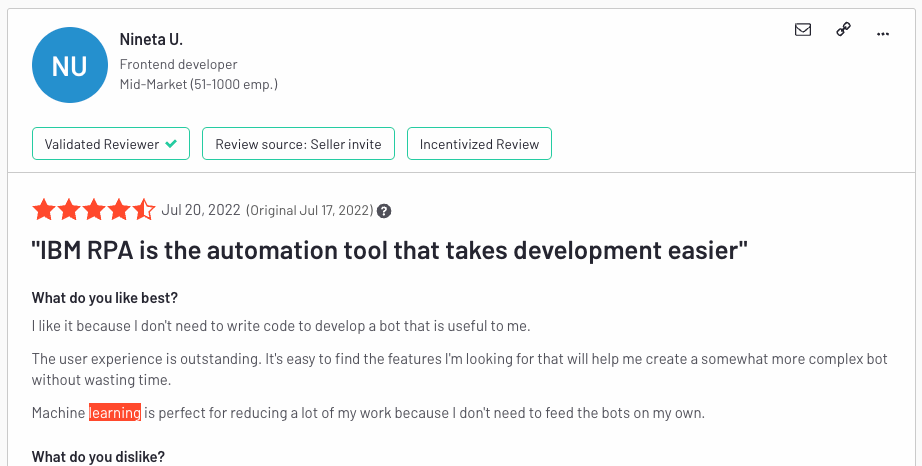
But RPA can have 100+ use cases across industries. And users say that in unique cases, UiPath’s artificial intelligence (AI) and cognitive features can fall short (Review 6). This specific reviewer works in the oil and gas industry, where some tasks can’t be easily automated.
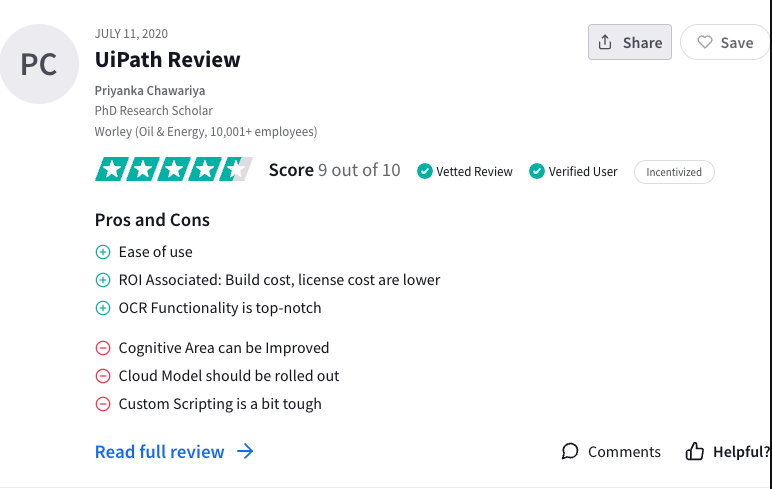
3. Debugging capability
Debugging is used in RPA testing to eliminate implementation issues. Performance and scalability is the biggest deployment issues for businesses. And a suboptimal debugging lowers process efficiency, and delays deployment and roll-out.
Unfortunately, neither UiPath nor IBM RPA has decent debugging capabilities. IBM RPA software users claim that when it comes to debugging, the documentation is thin (Review 7).
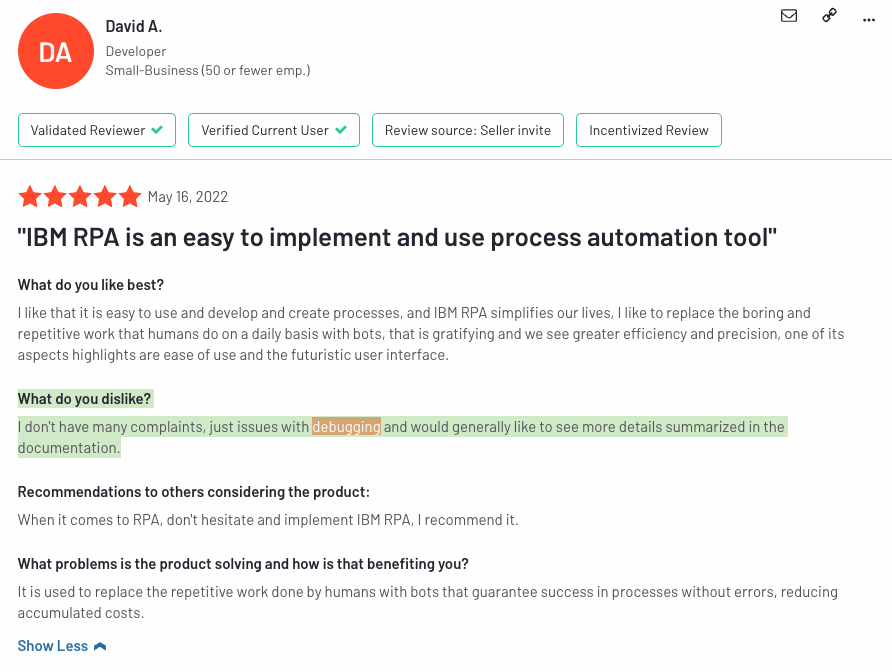
And an UiPath user claimed their customer experience with solving debugging issues haven’t been easy (Review 8).
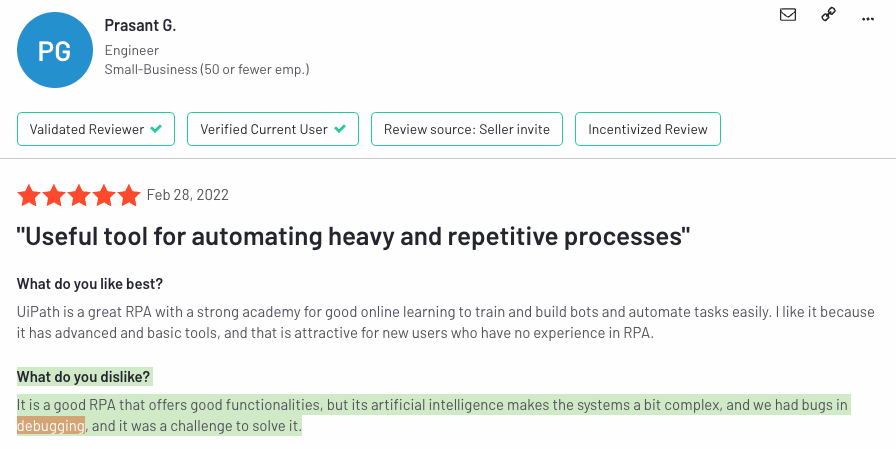
4. OCR functionality
OCR software robots enable intelligent reading, data extraction, and data transfer (ETL) from all the customers’ documents onto pre built templates without human error and human intervention. Especially if the RPA platform is deployed in an industry that deals with lots of contracts and documents, OCR and NLP features are important.
IBM intelligent reading is adequate, but it can’t understand foreign languages in images and PDFs, which limits its usability in international organizations that deal with languages other than English (Review 9).

UiPath’s software robots can sometimes be inaccurate. Inaccurate data entry is costly, and an organization would implement an RPA solution to reduce error-related costs, not compound it (Review 10).
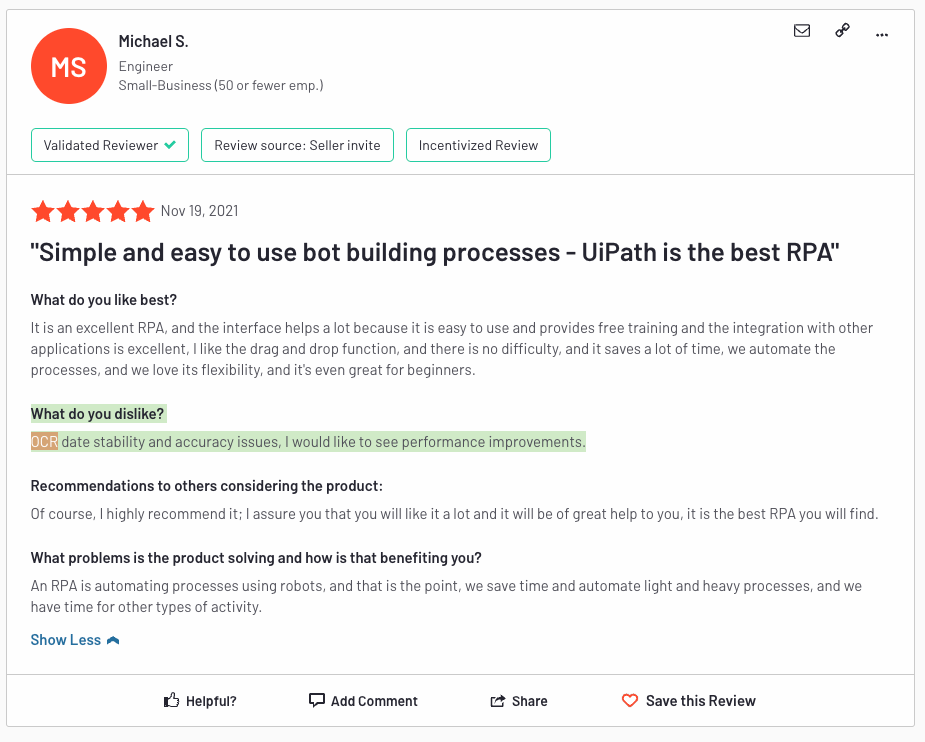
But in general, there is more user satisfaction for UiPath than for IBM (Review 11). And although IBM has advanced data extraction and feeding features, such as IBM datacap, UiPath gets the point here because of higher user review counts.
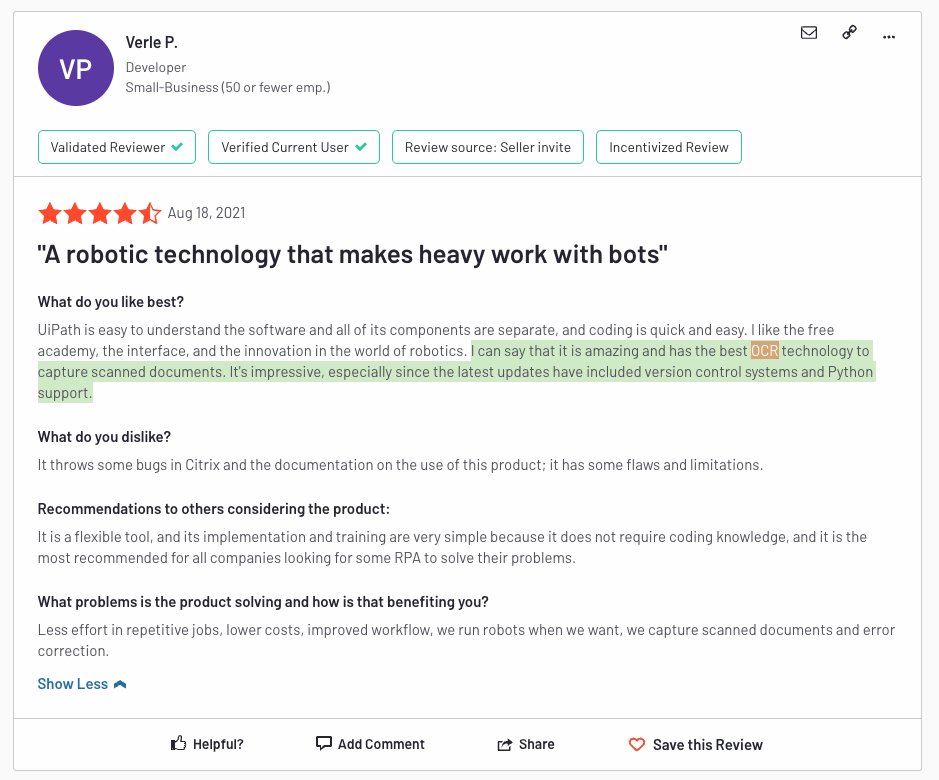
5. Process mining integration
We’ve looked at UiPath’s process mining integration vs IBM’s before. Process mining deployment is important in an RPA platform because it shows the automation-readiness and a high level view of your systems and processes.
This allows the company to start automating the systems that can benefit the most from automation, which translates to a faster ROI.
What we found was that IBM robotic process automation tool had better process mining support, number of users, integration, and features, such as process analysis, process notation, etc (Review 12).
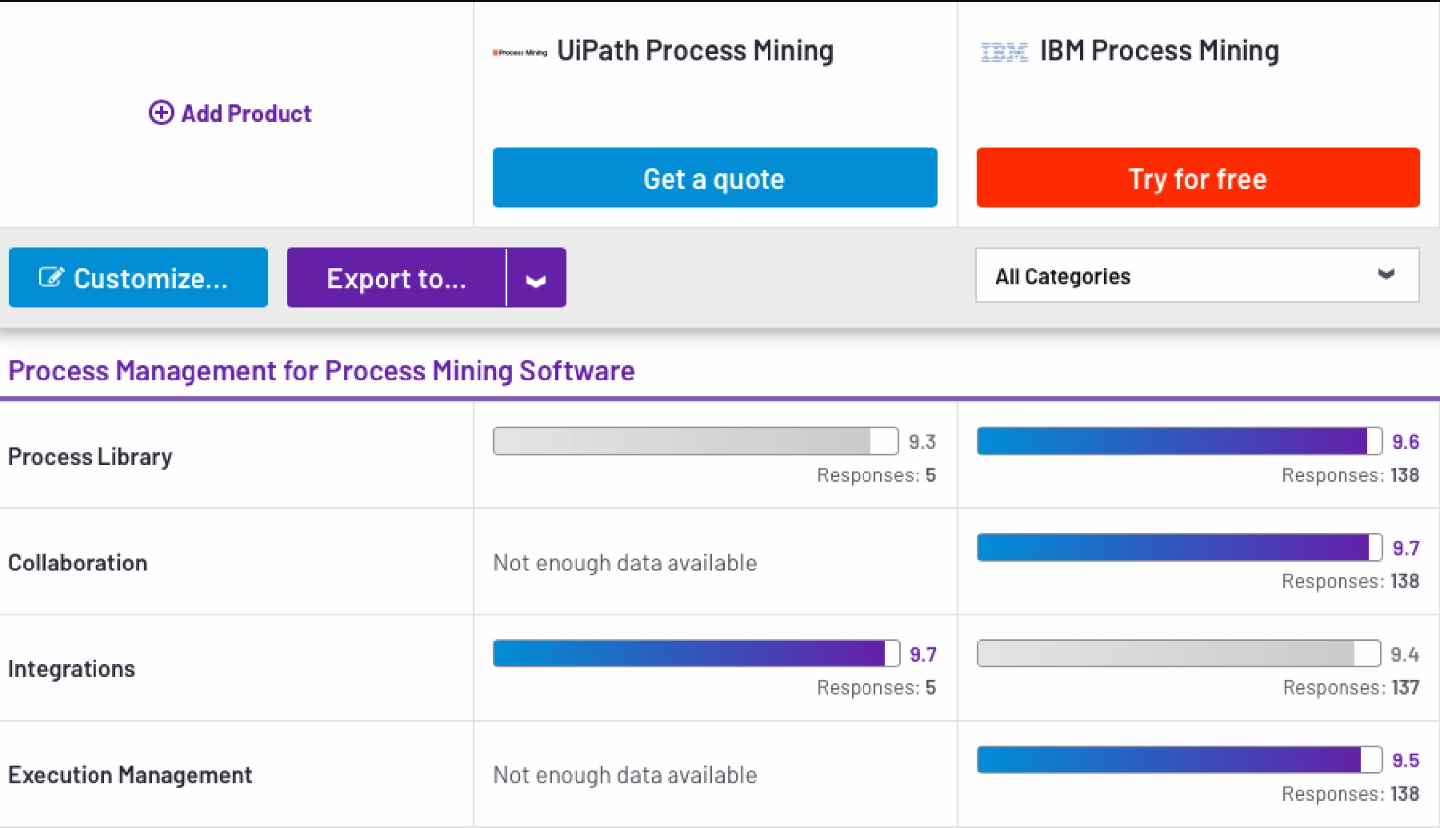
6. Customer support
According to Gartner, a positive customer experience convinces 82% of existing clients to repurchase the product. And because changing vendors isn’t easy/cheap, your partnership with a vendor should be viewed as a long-term project.
In Gartner’s reviews, IBM digital business automation solution and UiPath offer almost the same level of customer support.
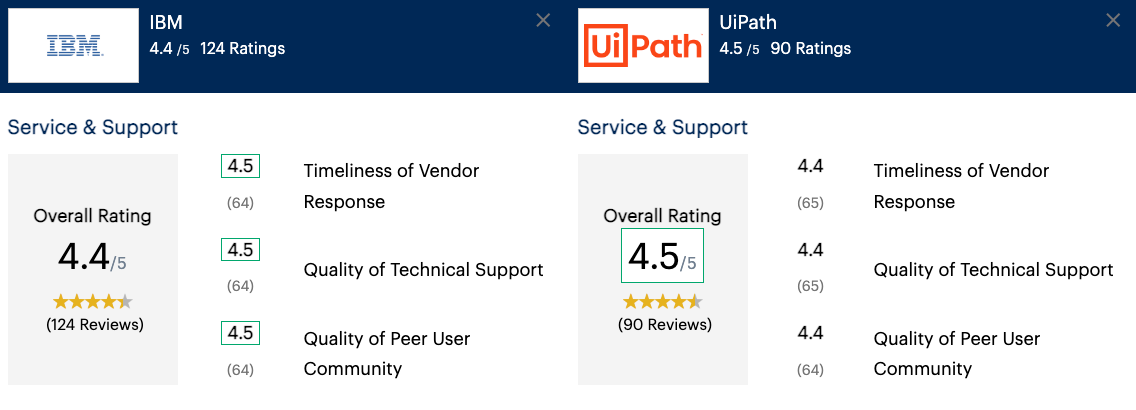
But on G2, IBM in comparison to UiPath, is significantly rated higher, 9.6 vs. 8.8. This implies that the processing of user complaints, reach-outs, and ticket resolution is done faster and more efficiently with IBM.
7. Ease of Setup/Deployment
Ease of use and ease of setup/deployment significantly affects customer satisfaction. The easier and quicker pilots are taken live, the faster the business needs are automated and digital transformation is achieved.
That is more important especially if the organization is deploying multiple attended bots/unattended bots for automating different business processes. The ease of use, set up, and implementation is higher for the IBM platform. This enables their adopters to automate their repetitive tasks quicker (Review 14).
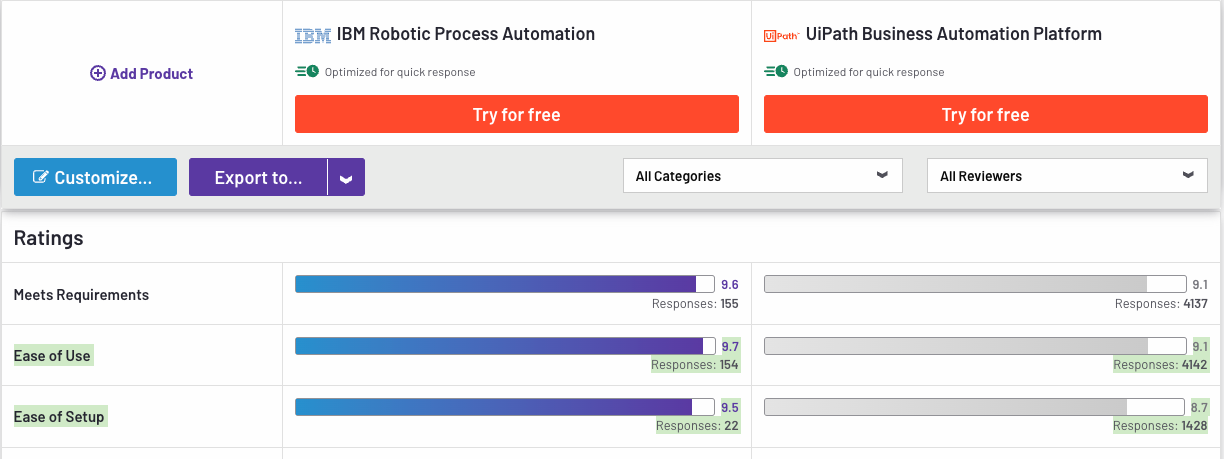
UiPath orchestrator sometimes crashes, the bot can’t locate the tool picker, and its integration with browsers is limited (Review 15).

The other downside is that the UiPath platform sometimes receives too many version updates, which decreases its usability and efficiency (Review 16).
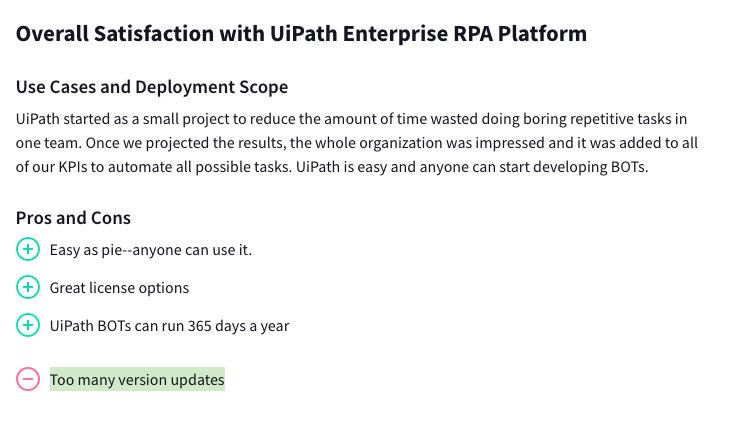
8. No-code functionality
Modern RPA tools all claim to have decent no-code software that enables the user to build multiple bots with little to no programming knowledge. Both IBM RPA and UiPath platform rank high in this category.
So in deployment, building, and processing, features such as screen recording, drag and drop interface, and prebuilt templates facilitate bots creation.
Both RPA platforms rank high in no-code category/ease of bot creation. But IBM RPA ultimately beats UiPath on all factors related to bot building (Review 17). Especially for small businesses that cannot afford the services of RPA developers, no-code tool in a solution can be the most important factor in choosing a vendor.

9. Bot management
Bot management in an RPA platform refers to:
- Bot scheduling
- Attended and unattended automation features
- Visible dashboard for process monitoring and analytics
- Robust rules governance, visible audit logs, and data security features which lower operational and compliance risk
In these areas, IBM robotic process automation delivers a better performance than UiPath (Review 18). So for instance, a user can run their attended bots better on IBM software, or can take over from them more efficiently, when needed.
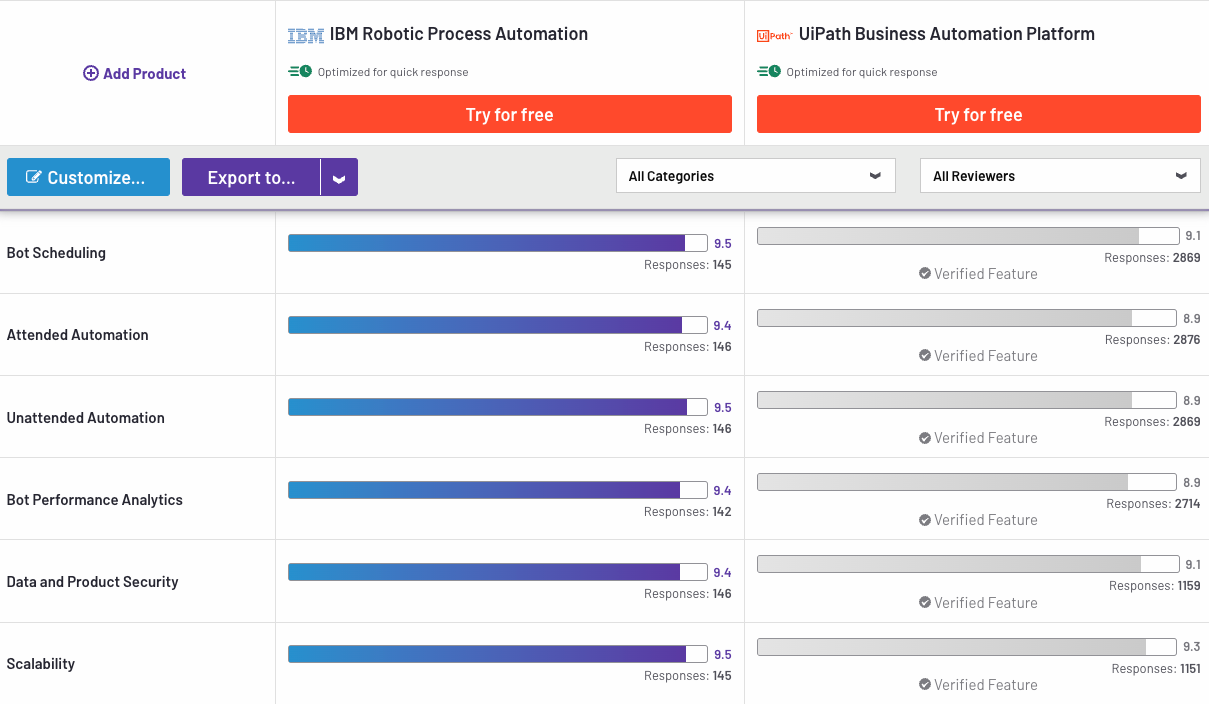
10. Scalability
Scalability enables the RPA platform to take on additional processes, or deal with large amounts of data more easily. A scalable RPA platform is important because it enables the automation of more business processes.
The majority of UiPath RPA platform user base is composed of companies with +1000 employees. In comparison, IBM users are mainly small businesses with 50 employees or less.
This is a token that UiPath’s has a stronger scalability power for automating more of the existing processes (Review 19).
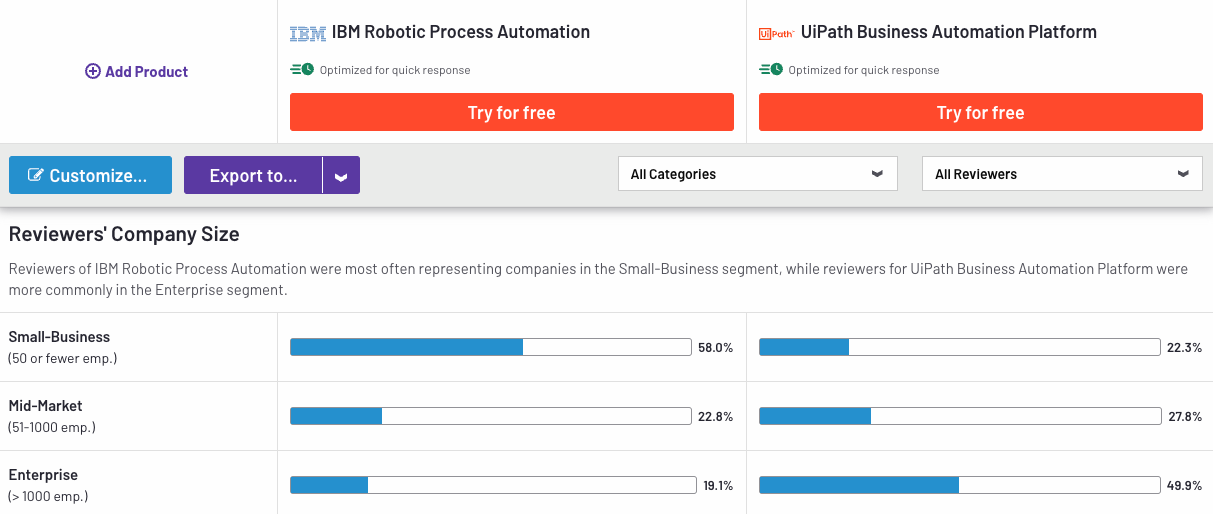
11. Language support
With advancement in translating models, language barriers should no longer be a barrier to automation. IBM RPA can support 7 languages: English, Chinese, French, Japanese, Spanish, Portuguese and Korean.

In comparison, UiPath’s platform supports 4 languages: English, French, Japanese and Russian. So if your IT team is composed of workforce not comfortable with English on the application interface, IBM robotic process automation platform gives them more options.

12. Industry suitability
An important factor to check before signing up with a vendor is to see their references and check if they can automate/have automated the tasks that are specific to your industry.
IBM RPA software is popular with companies in the following industries:
- IT
- Telecommunication
- Consumer services such as sales
- Retail
- Management consulting
In comparison, companies in the:
- IT
- CS
- Financial services
- Telecommunications
- The Pharmaceuticals industry use the UiPath platform for automating their business processes.
We will not consider this factor in our ranking process as there’s no right or wrong industry to be in. This was an observation.
13. OS support
With more offices today using Mac than before, the RPA platform should work seamlessly on macOS and Windows. UiPath doesn’t offer native macOS support (Review 22).

IBM automation, too, doesn’t natively have macOS integration. We tried both IBM and UiPath on a Mac computer to check the experience. IBM offers their service on a virtual, cloud-based Windows desktop (Review 23).

In comparison, the UiPath service is offered via a virtualization of UiPath Studio on Mac (Review 24). We found theirs harder to setup on Mac. But because no user mentioned that, we will not count it in our performance assessment.
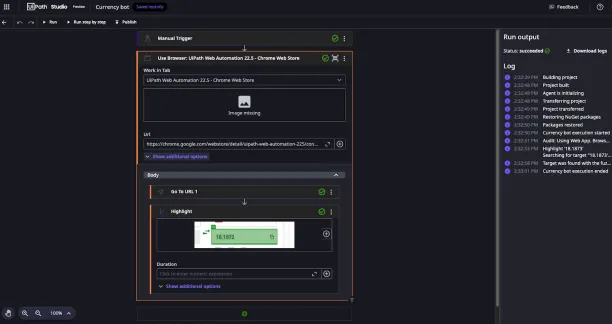
Summarized Table
| Features | UiPath | IBM |
|---|---|---|
| Cost | ✓ | |
| Cognitive capability | ✓ | |
| Debugging capability | x | x |
| OCR functionality | ✓ | |
| Customer support | ✓ | |
| Ease of Use & Ease of Setup | ✓ | |
| No-code functionality | ✓ | |
| Bot management | ✓ | |
| Scalability | ✓ | |
| Support of +4 Languages | ✓ |
Disclaimer
If we say, “The user is are happy with vendor X,” that’s not true for all customers. It means that based on the reviews that we were able to read, across multiple platforms in a limited time, we generally saw Vendor X’s customers saying they are happy. Or if we say, “Vendor Y can improve its Z capability,” we are talking on behalf of Vendor Y’s adopters. We can’t independently test all functionalities. It would depend on organization, industry, use case, etc.
For more on RPA vendors
To learn more about other RPA vendors comparison articles, read:
- Top 3 Blue Prism Alternatives According to Business Users
- 3 Appian Alternatives Suitable For Larger Companies
- Top 4 Power Automate Alternatives for Process Automation
If you are ready to invest in an RPA software, we have a data-driven list of RPA vendors prepared. We can help you through the selection journey:

Cem has been the principal analyst at AIMultiple since 2017. AIMultiple informs hundreds of thousands of businesses (as per similarWeb) including 60% of Fortune 500 every month.
Cem's work has been cited by leading global publications including Business Insider, Forbes, Washington Post, global firms like Deloitte, HPE, NGOs like World Economic Forum and supranational organizations like European Commission. You can see more reputable companies and media that referenced AIMultiple.
Throughout his career, Cem served as a tech consultant, tech buyer and tech entrepreneur. He advised businesses on their enterprise software, automation, cloud, AI / ML and other technology related decisions at McKinsey & Company and Altman Solon for more than a decade. He also published a McKinsey report on digitalization.
He led technology strategy and procurement of a telco while reporting to the CEO. He has also led commercial growth of deep tech company Hypatos that reached a 7 digit annual recurring revenue and a 9 digit valuation from 0 within 2 years. Cem's work in Hypatos was covered by leading technology publications like TechCrunch and Business Insider.
Cem regularly speaks at international technology conferences. He graduated from Bogazici University as a computer engineer and holds an MBA from Columbia Business School.
To stay up-to-date on B2B tech & accelerate your enterprise:
Follow on

Comments
Your email address will not be published. All fields are required.